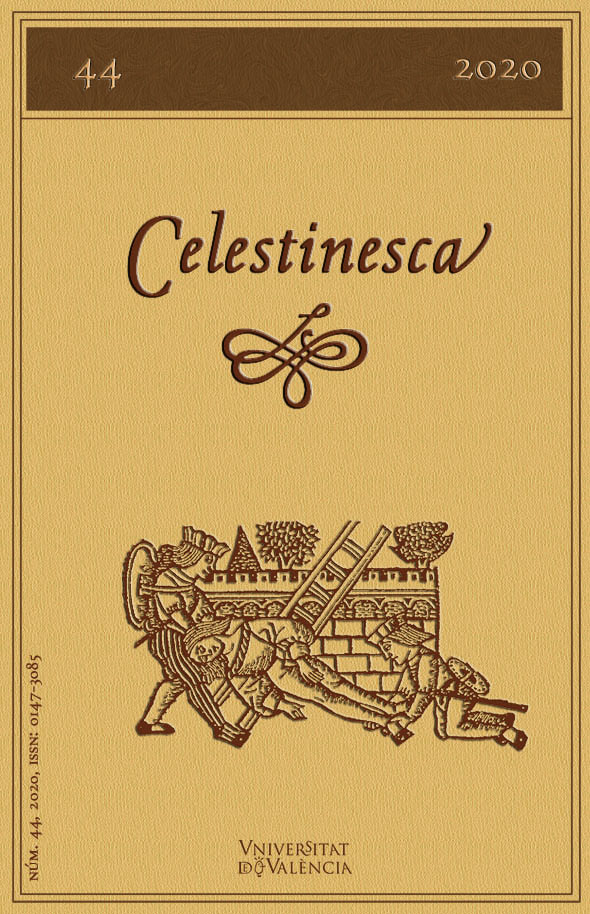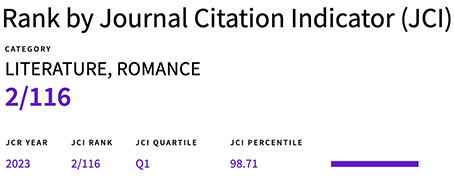Fernando de Rojas and La Celestina through historical fiction: authorship and Jewish descent
DOI:
https://doi.org/10.7203/Celestinesca.44.19431Keywords:
Fernando de Rojas, La Celestina, Inquisition, double autorship, historical fiction Abstract
Abstract
In this paper I analyze several historical novels published after 1990 in which the main character is Fernando de Rojas. The goal is to ascertain the kind of subjects related to Celestina and its supposed author present in these works. Most of them follow the theory of Celestina’s doble authorship, widely accepted today. We can also find in these novels a more controversial theory, according to which Rojas would be a direct descendant from a prisoner sentenced to death. The presence of this theory in historical novels could be explained not only by the influence of the works of Stephen Gilman, but also of the reception of the work from the 20th century on, both because of the relevance that the inquisitorial element acquires and the more critical reading of the Tragicomedy and the superposition of the imaginary of the historical narrative.
 Downloads
Downloads
 References
References
Arce, Juan Carlos (1991), Melibea no quiere ser mujer, Barcelona, Planeta.
Botta, Patrizia (1999), «La autoría de La Celestina», en Edizione critica della «Celestina» di Fernando de Rojas (dall’Atto viii° alla Fine). http://rmcisadu.let.uniroma1.it/celestina/celest.htm
José Luis (2007), «Celestina: "sic et non". ¿Libro escolar-universitario?», Celestinesca 31, pp. 23-58. https://doi.org/10.7203/Celestinesca.31.20068
— (2017), «The Early Editions and the Authorship of Celestina», en A Companion to «Celestina», Leiden-Boston, Brill, pp. 21-40. https://doi.org/10.1163/9789004349322_003
— (2018), «De nuevo sobre la autoría de La Celestina», Letras 77, pp. 35-68. https://erevistas.uca.edu.ar/index.php/LET/article/view/1710
Cantalapiedra, Fernando (ed.) (2000), Anónimo/Fernando de Rojas. Tragicomedia de Calisto y Melibea, Kassel, Reichenberger, 3 vols.
François, Jéromine (2018), «Reescribir La Celestina del siglo XIX al XXI: estrategias peritextuales», Bibliographica 1.2, pp. 170-220. https://doi.org/10.22201/iib.bibliographica.2018.2.17
François, Jéromine (2019) «"Conjúrote, triste Plutón...": reescrituras contemporáneas de la hechicería de Celestina», Monografías Aula Medieval 10, pp. 79-100. http://parnaseo.uv.es/AulaMedieval/aM_es/StorycaWeb/conjurote-triste-pluton-reescrituras-contemporaneas-de-la-hechiceria-de-celestina/
Garci-Gómez, Miguel (1992), «Un tercer autor para la Tragicomedia. La informática al servicio de la literatura», Celestinesca 16.2, pp. 33-62. https://doi.org/10.7203/Celestinesca.16.19812
García Jambrina, Luis (2008), El manuscrito de piedra, Madrid, Alfaguara.
— (2010), El manuscrito de nieve, Madrid, Alfaguara.
— (2017), «Naturalmente, dos manuscritos: dos novelas históricas sobre el final de la Edad Media en Salamanca», Monografías Aula Medieval 6, pp. 4-13. http://parnaseo.uv.es/AulaMedieval/aM_es/StorycaWeb/novelas-historicas-salamanca/
— (2018), El manuscrito de fuego, Barcelona, Espasa.
— (2019), El manuscrito de aire, Barcelona, Espasa.
Gilman, Stephen (1978), La España de Fernando de Rojas, Madrid, Taurus.
Heras, Moisés de las (2000), Escuchando a Filomena, Barcelona, Muchnik.
Huertas Morales, Antonio (2012), «El pasado se viste de negro: Fernando de Rojas, pesquisidor. Entrevista a Luis García Jambrina», Cuadernos de Aleph 4, pp. 165-172.
— (2015), La Edad Media contemporánea: Estudio de la novela española actual de tema medieval (1990-2012), Vigo, Academia del Hispanismo.
— (2016), «Manuscritos medievales en la novela española contemporánea», Revista de Poética Medieval 30, pp. 155-178. https://doi.org/10.37536/RPM.2016.30.0.50289
Infantes, Víctor (1998), «Los libros "traydos y viejos y algunos rotos" que tuvo el Bachiller Fernando de Rojas, nombrado autor de la obra llamada Celestina», Bulletin Hispanique 100.1, pp. 7-51. https://doi.org/10.3406/hispa.1998.4957
— (2007), «Fernando de Rojas: el lector desvelado (en su caligrafía). De nuevo sobre el "Inventario" de sus libros», Celestinesca 31, pp. 103-118. https://doi.org/10.7203/Celestinesca.31.20072
Miguel, Emilio de (1996), La Celestina de Rojas, Madrid, Gredos.
Rodiek, Christoph (1989), «La Celestina del siglo XX: anotaciones comparatistas», Celestinesca 13.2, pp. 39-44. https://doi.org/10.7203/Celestinesca.13.19706
Rojas, Fernando de (y «antiguo autor») (2016), Tragicomedia de Calisto y Melibea, Francisco J. Lobera, Guillermo Serés, Paloma Díaz-Mas, Carlos Mota, Iñigo Ruiz Arzálluz y Francisco Rico, Madrid, RAE.
Sáez Pascual, M.ª Victoria (2001), «El componente enigmático de La Celestina y la audacia imaginativa de Juan Carlos Arce: poderosos alicientes para jóvenes lectores», en La Celestina, V centenario (1499-1999), coords. Felipe Blas Pedraza Jiménez, Gema Gómez Rubio y Rafael González Cañal, Cuenca, Universidad de Castilla-La Mancha-Cortes de Castilla-La Mancha, pp. 511-518.
Salvador Miguel, Nicasio (1989), «El presunto judaísmo de La Celestina», en The Age of the Catholic Monarchs, 1474-1516. Literary Studies in Memory of Keith Whinnom, Liverpool University Press, 1989, pp. 162-177.
— (1991), «La autoría de La Celestina y la fama de Rojas», Epos 7, pp. 275-290. https://doi.org/10.5944/epos.7.1991.9757
— (1993), «La Celestina y el origen converso de Rojas», en Ex libris. Homenaje al profesor José Fradejas Lebrero, ed. de José Romera, Antonio Lorente y Ana M.ª Freire, Madrid, UNED, pp. 181-189.
— (2002), «De nuevo sobre el presunto judaísmo de La Celestina (con unas gotas de sociología crítica)», en El legado de los judíos al Occidente europeo. De los reinos hispánicos a la monarquía española. Cuartos encuentros judaicos de Tudela, Pamplona, Universidad Pública de Navarra, pp. 83-102.
Serrano y Sanz, M. (1902), «Noticias biográficas de Fernando de Rojas, autor de La Celestina, y del impresor Juan de Lucena», Revista de Archivos, Bibliotecas y Museos 6, pp. 245-299.
Snow, Joseph T. (2005−2006), «La problemática autoría de Celestina», Incipit XXV-XXVI, pp. 537-561. http://www.iibicrit-conicet.gov.ar/ojs/index.php/incipit/article/view/305
Valle Lersundi, Fernando del (1929), «Testamento de Fernando de Rojas, autor de La Celestina», Revista de Filología Española 16, pp. 366-388.
Valverde Azula, Inés (1992), «Documentos referentes a Fernando de Rojas en el archivo municipal de Talavera de la Reina», Celestinesca 16.2, pp. 81-104. https://doi.org/10.7203/Celestinesca.16.19815
— (1999), «Rojas y Talavera», en Un autor, una ciudad, un tiempo Fernando de Rojas y la Talavera del s. XVI, Talavera de la Reina, Colectivo de Investigación Histórica ARRABAL, pp. 10-33.
Downloads
Published
How to Cite
-
Abstract1331
-
PDF (Español)643
Issue
Section
License
![]() Celestinesca is committed to the dissemination of knowledge, that is why access to its contents is free and is ruled by a Creative Commons Attribution-NonCommercial-NoDerivatives 4.0 license.
Celestinesca is committed to the dissemination of knowledge, that is why access to its contents is free and is ruled by a Creative Commons Attribution-NonCommercial-NoDerivatives 4.0 license.
Authors retain the rights to their works. Therefore, they can disseminate them and deposit them in the repository, institutional or not, that they wish. However, they are kindly requested to do so by providing the full bibliographic reference and the corresponding DOI.
Celestinesca does not charge authors for submitting, processing, reviewing or publishing their articles.





